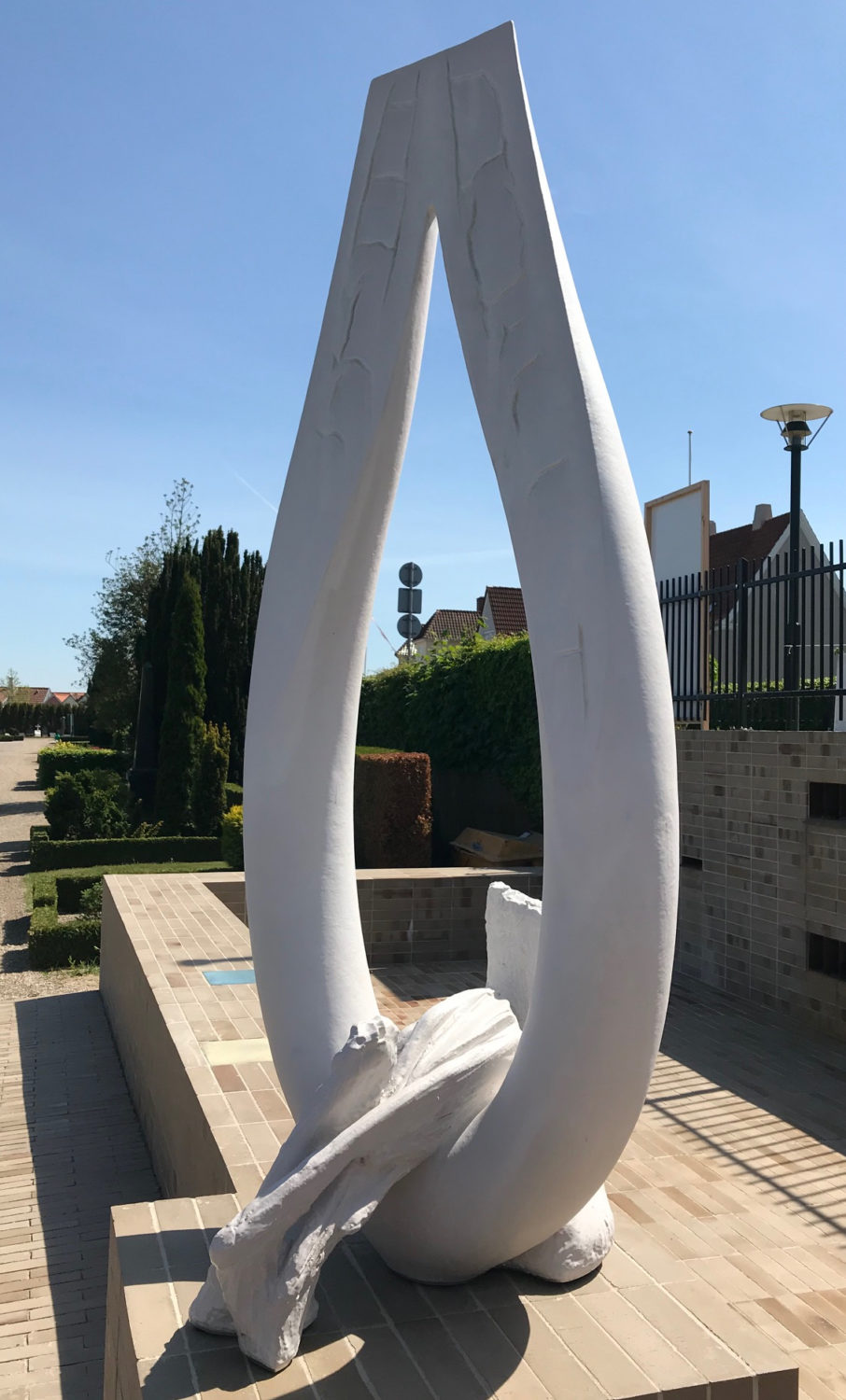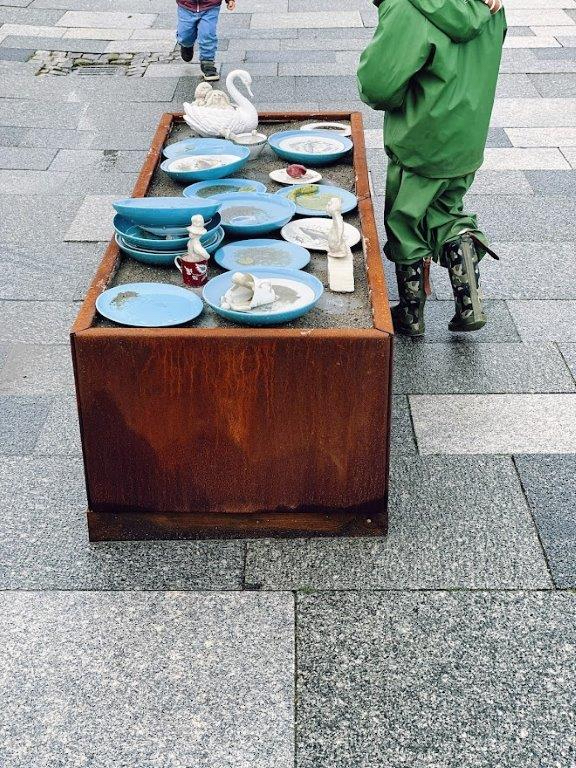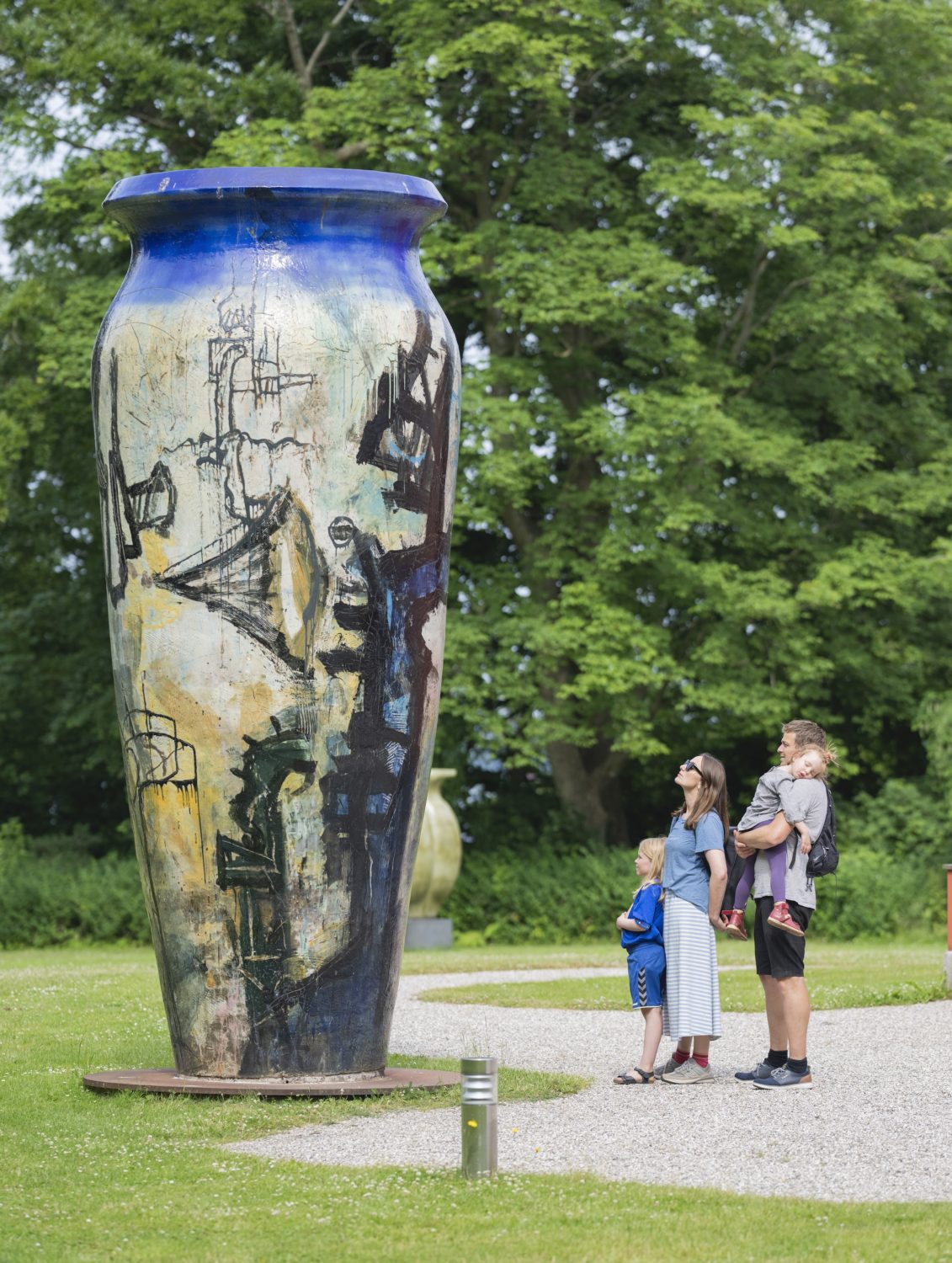Denmark’s first ceramics route
With a background view of both bridges across the Little Belt strait, Gunhild Rudjord’s large ceramic vessel stands calmly on the cemetery in Middelfart, letting wind, weather and the changing seasons pass over it. The shades of green, the runny glaze and the large, stylized flowers give the impression of an eternal promise of springtime and growth. The view in the other direction reveals more ceramic art: Per Ahlmann’s installation Altings tøven (The Hesitation of Everything), a white drop-shaped object placed in water. These works of art are some of the first stops in place on Denmark’s first ever ceramics route, which runs through the centre of Middelfart, emphasizing the town’s new identity as a ceramics destination. The route map guides visitors via the Kongebrovej street to the old part of the market town, and on the square in front of Sankt Nicolai church, one encounters the next ceramic artwork: Magne Furuholmen’s Rook Takes Bishop, a black and a white ceramic pillar mirroring each other, surrounded by the oldest buildings in town.

The first version of the route was officially opened in August 2021, and over time, the art that is currently on display will be joined by additional pieces throughout the route. In addition, ceramics will be featured in the form of paving and signage.
Not surprisingly, the initiative for the project came from CLAY Museum of Ceramic Art Denmark, which is housed in the iconic red ‘Grimmerhus’ villa next to the cemetery, with a magnificent view of Little Belt, about half a kilometre from the centre of town.
CLAY has long sought to establish closer ties between museum and town. After its first major expansion in 2015, the museum is now adding another section in reflection of the growing interest in ceramics and ceramic art; a field that draws visitors from all over Denmark and the rest of the world to Middelfart.
Art round the clock – a strong current trend in contemporary art
The ceramics route expands the museum territory and takes ceramic art into the landscape, where it is accessible at all hours of the day to anyone who follows the trail. It also draws museumgoers into the surrounding landscape and into town to experience even more ceramic art.
The strategy is appealing to the Municipality of Middelfart, which would like to see the ceramics route become perhaps the town’s main attraction: ‘A beautiful walk along the Little Belt strait dotted with great works of art,’ to quote the vision paper for the ceramics route. The project was approved by Middelfart City Council in 2018 and is now included in the municipal development plan for the town centre, ‘Mulighedernes Middelfart’ (Middelfart, a Town of Possibilities).
Art routes are a strong current trend in contemporary art, and the pandemic has only made it more relevant to offer art experiences al fresco. Outdoor art displays are open round the clock, pandemic-safe, easily accessible and approachable.
The BIKE ART TOURS concept now includes art cycling routes in Roskilde, Copenhagen, Aarhus, Aalborg, Odense and Esbjerg, curated and promoted by museums and art centres. Herning and Holstebro were also among the first-movers in the drive to bring more art into the public space, and most recently, the art museum ARKEN in Ishøj, south of Copenhagen, turned the walk from the train station to the museum on Køge Buge (Køge Bay) into the art route Arken Walk.
Art routes typically call for large-scale works of art in sturdy materials that engage in a dialogue with their environment, but they also offer a high degree of latitude beyond traditional sculptures.

An art appreciation project
The trend might be summarized as ‘taking art into the world’, and the rapid production and turnover rate of exhibitions inside museums and art centres makes the more permanent art routes, where the art grows into the landscape or the urban scene, seem even more appealing.
‘This is art for everybody, always, also for those who don’t actively seek it out,’ says Pia Wirnfeldt, the director of CLAY, who points to the obvious cultural benefits for the local area of allowing the ceramic art to spread into the community.
‘I don’t see it as a static thing, a route that is established once and for all. Although we have defined the intention and the course of the ceramics route, it should be a dynamic project, where new things are added over the years, so that there’ll always be something new to experience.’
Today, several of the stops on the route are small, temporary exhibitions created by local schoolchildren in cooperation with ceramicist Jette Löwén: cups, plates, lids and other everyday ceramic items have been used to build little hobbit-like houses that form a tiny ceramic village in large boxes, one of them standing on the edge of CLAY’s big garden right on the coast, the other on Culture Island in the centre of town.
These simple but effective collective projects demonstrate the local ownership and engage young families, reflecting the ambition of community engagement that is a key priority, especially for the municipality. In the commissioning new works of art for the route from Danish and international artists over the coming years, there will be an emphasis on site-specific projects that engage the local community; an outreach strategy that is also pursued by the art centre Kunsthal 6100 in Haderslev, among others.

The outdoor placement invites more monumental works of ceramic art, which only adds to the local connection: not far from Middelfart lies Tommerup Ceramic Workcenter, the only place in Denmark capable of firing the largest ceramic objects. With Tommerup as a project partner, CLAY is able to offer invited ceramicists and artists a workshop where they can produce their contributions to the route.
To Pia Wirnfeldt, high artistic quality is a key condition: ‘We shouldn’t rush but do things properly. It’s better to add a few great pieces that create a stir and then allow the project to develop in a more fluid way.’
Architecture has to adapt to the terms of the clay
The ceramics route in Middelfart stands out from other Danish art routes by giving craft and craft-based art pride of place. The only global counterpart is the village of Mazara del Vallo on the island of Sicily, which is embellished with vases, decorated tiles, paintings and ceramic signs throughout. The Sicilian route is known as ‘the mayor’s ceramics route’, because the town’s mayor, Nicholo Christaldi, is himself among the contributing artists.
Middelfart has a different level of ambition, matching CLAY’s increasingly international level. ‘Ceramic is well-suited for being placed outdoors,’ Pia Wirnfeldt explains. ‘It is a durable material, and in addition, there is a unique connection between nature and ceramics, between the soil and ceramic clay.’
In Middelfart, that connection is intense, and not always easy to manage, as the western part of town rests on a layer of unstable Little Belt clay, which can pose problems for builders. To overcome this challenge, CLAYS’s new large extensions are ingenious constructions floating on a cushion of air and tethered to the terrain with steel wire to prevent the movements of the Little Belt clay from gradually shifting the buildings. The entire area is less built-up and thus offers greater natural amenities.
In Middelfart, architecture has to adapt to the terms of the clay. With sea on three sides, the town also has to take the rising sea levels that come with climate change deeply seriously. Due to the Little Belt clay, water drains very slowly into the underground, as explained by Thorbjørn Sørensen, the director of the town’s technical and environmental department.
The town has to be designed to handle heavy rains by allowing large amounts of water to pass through without doing damage. Fortunately, the old port is constructed to handle being completely flooded, while the new port will require hard edges or a dyke. In the old part of town, water can flow freely through the streets, which are currently being redesigned with a suitable incline towards more open areas in order to spare the houses.
In this effort, ceramic comes into play once more, as the buildings will be clad with ceramic tiling to protect them from flood damage. That offers an additional opportunity for decoration and aesthetic solutions, and the areas that feature ceramic cladding will be obvious sites for some of the art along the ceramics route.

Hidden in the clay
Middelfart has declared itself a climate town and a climate laboratory for the development of new types of climate solutions in cooperation with researchers and green businesses. The partnership with CLAY adds new dimensions, as the ceramics route and the planned ceramic features in town link climate adaptation and aesthetics. Certain elements of the town need to be adapted, and it makes sense to seize this opportunity to create a more beautiful urban space and reap the benefits this has for quality of life and local identity.
This focus on climate solutions has been noticed around the world, and Middelfart annually welcomes about 45 delegations from countries seeking inspiration for their own future initiatives, says Thorbjørn Sørensen. To meet this demand, the municipality is planning to build a climate visitor centre, ideally situated on the harbour front, perhaps even in direct contact with the water. And naturally, the climate visitor centre should feature ceramic decorations.
The ceramics route and the vision of Middelfart as a ceramics destination has been embraced by the local residents, as reflected in a community initiative to decorate two contemporary residential buildings. One of the first sights to greet people on their way from the train station in Jernbanegade is the monotonous red-brick facades of two new-built housing blocks, which are virtually crying out to be decorated.
The ceramics route inspired the housing association Lillebælt Boligforening to initiate a decorative project, and with assistance from CLAY, a call went out, which resulted in two sketch projects. If everything goes according to plan, the two buildings will soon undergo a transformation from generic housing blocks to a new aesthetic attraction in town.
The project is a good example of the added value generated by aesthetic projects, such as the ceramics route: shaping and embellishing the town is a fundamentally democratic project, which can be powered by local engagement and which boosts both identity and ownership. The humble clay holds many hidden treasures.


